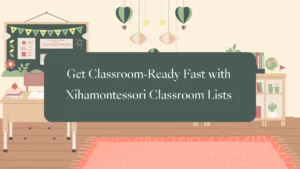Starting outdoor classrooms can seem like a daunting task, but the benefits it brings to children’s learning and development are immeasurable. From fostering a love for nature to enhancing physical health, the advantages are vast.
Outdoor classrooms offer a dynamic and engaging learning environment that cannot be replicated indoors. They provide preschool children with the opportunity to explore, engage with, and learn from the natural world around them. This hands-on approach to learning helps develop critical thinking skills, encourages physical activity, and fosters a lifelong appreciation for the environment.
The concept of taking the classroom outside is not just about learning in a different space; it’s about transforming the way we think about education.
What are the Essential Components of Successful Outdoor Classrooms?
Creating successful outdoor classrooms requires more than just moving the indoor learning environment outside. It involves thoughtful planning and design to create a space that is not only conducive to learning but also safe, engaging, and in harmony with nature. Here are key components that form the foundation of an effective outdoor classroom:
- Versatile Learning Zones
- Sensory and Discovery Elements
- Sustainable and Eco-friendly Design
- Safety and Accessibility
- Community and Cultural Integration
- Educational Resources and Materials
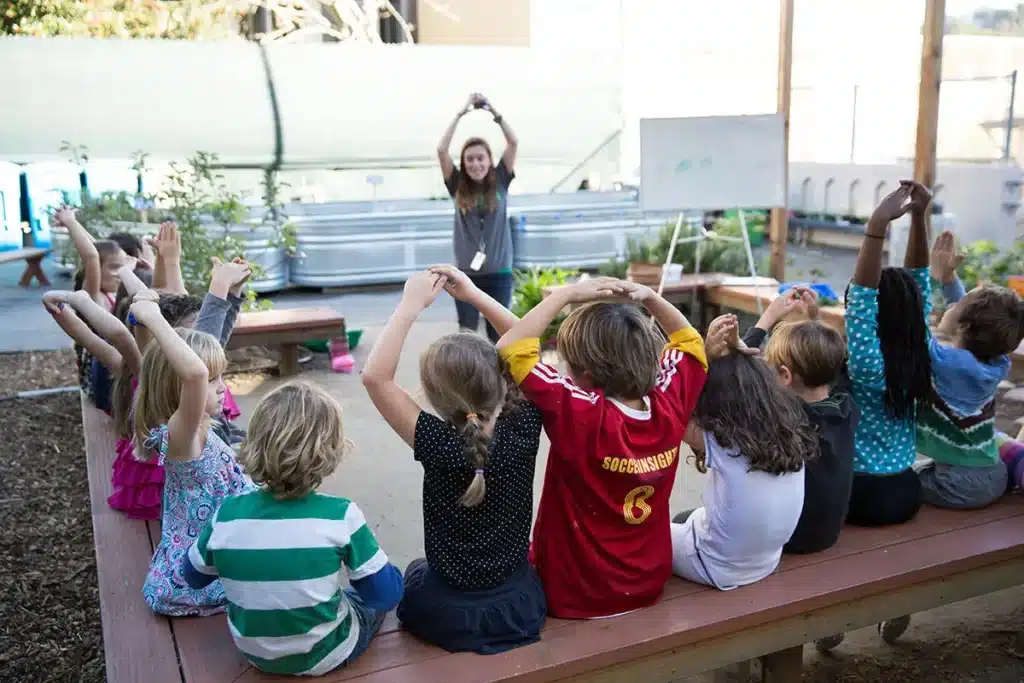


The essential components of a successful outdoor classroom are multifaceted, requiring careful consideration of the learning environment’s design, functionality, and educational purpose. By incorporating these elements, educators can create an outdoor classroom that not only enriches the learning experience but also promotes a deeper connection with the natural world, encourages physical activity, and supports holistic development. A well-planned outdoor classroom is a dynamic and versatile space that brings learning to life in the most engaging and meaningful ways.
How to Plan an Outdoor Classroom in Preschool: Questions to Consider
Before creating an outdoor classroom in preschool, it’s important to ask the right questions. Every preschool setting is different, and thoughtful planning ensures the space truly meets the needs of the children and educators. Use the questions below to guide your decision-making process and build an outdoor classroom that is safe, engaging, and developmentally appropriate.
1. What are the age groups of the children using the space?
Younger preschoolers may need more support with balance and safety, while older children might be ready for more adventurous play or complex learning zones. Consider the physical and cognitive abilities of your students when choosing equipment and activity areas.
2. How much outdoor space is available?
Do you have access to a large open field, a small courtyard, or a shared playground? The size and shape of the area will influence layout decisions, such as how many learning zones you can include and whether you need movable or permanent structures.
3. What are your learning goals for the outdoor classroom?
Are you aiming to support physical development, encourage nature exploration, enhance sensory play, or incorporate STEM learning outdoors? Defining educational objectives early on helps guide the selection of materials and activities.
4. What natural features or existing resources can be used?
Are there trees for shade, grassy areas for free play, or garden beds that can be repurposed? Building around what you already have not only reduces cost but also helps create a more sustainable and integrated environment.
5. What level of supervision and safety does the space require?
Think about visibility, boundaries, soft ground surfaces, and how easily teachers can move among different zones. Safety planning should be aligned with the children’s developmental stage and the activities offered.
6. How will the space be maintained and used across seasons?
Will the outdoor classroom be open year-round? If so, what materials or shelter structures are needed to adapt to different weather conditions? Planning for seasonal rotation also keeps the environment fresh and engaging.
How Can You Create Effective Outdoor Classrooms?
1. Designing Nature-Inspired Learning Environments
- Detail the Planning Process: Discuss the steps in choosing the right plants, structures, and layout that mimic natural ecosystems. Emphasize the importance of native plant species and creating habitats for local wildlife
- Incorporate Educational Objectives: Explain how this environment can teach children about biodiversity, plant life cycles, and the importance of conservation.
Creating a nature-inspired learning environment involves more than just physical elements; it’s about fostering a deeper connection between children and the natural world. To achieve this, consider incorporating a variety of ecosystems within the outdoor classroom, such as a small pond ecosystem where children can observe aquatic life, learn about water cycles, and understand the importance of water in sustaining life. Surround this with a butterfly garden filled with native flowers that attract local butterfly species, providing a hands-on lesson in pollination and the importance of biodiversity.
Incorporating elements that change with the seasons offers ongoing learning opportunities. For example, deciduous trees not only provide shade in the summer but also teach lessons about the seasons as they lose their leaves in the fall. This ever-changing environment encourages children to observe, question, and learn from the natural world around them daily.
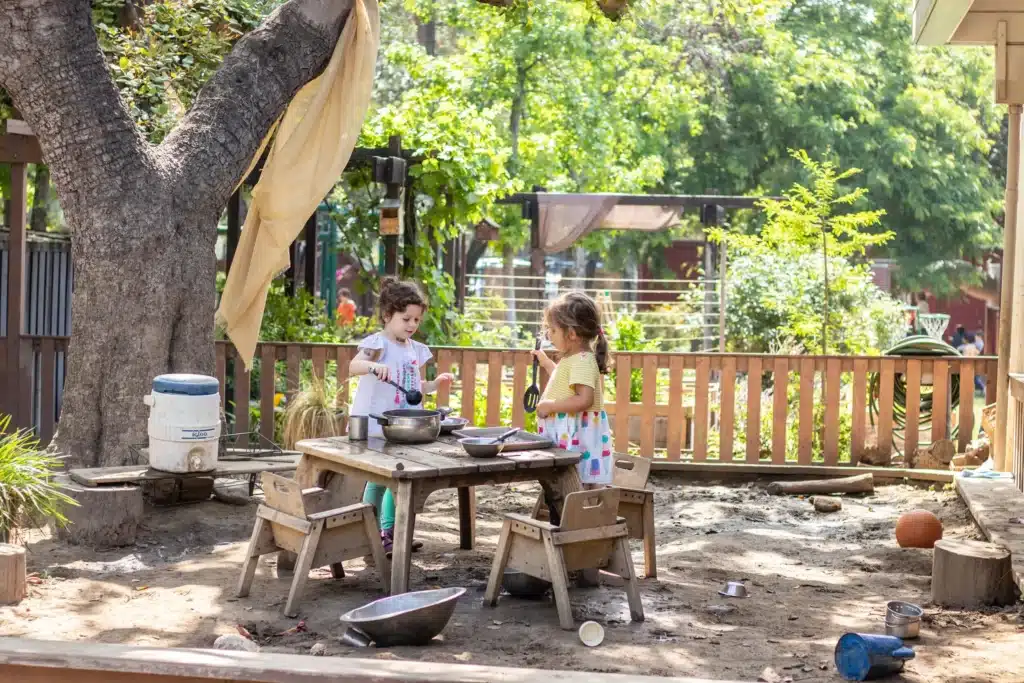

2. Creating Interactive Garden Spaces
- Explain Garden Types: Describe various garden types (sensory, vegetable, butterfly) and their roles in sensory learning and ecological education.
- Outline Activities: Provide examples of hands-on activities like planting, harvesting, and composting, and how they integrate with curricular goals.
An interactive garden space in an outdoor classrooms goes beyond planting and harvesting. It can be designed to teach children about different types of plants and their growth conditions. For instance, creating separate zones for vegetables, fruits, herbs, and flowers allows children to learn about the variety within the plant kingdom. Incorporating raised beds or containers can make gardening accessible for all children, including those with physical disabilities, ensuring inclusivity.
Gardens can also be used to teach cross-curricular lessons. Math concepts like counting, measuring plant growth, and geometry (through garden layout design) can be integrated. Science lessons on plant biology, life cycles, and even simple chemical reactions (such as those occurring during composting) can be rooted in the garden. This approach not only enriches children’s learning experience but also helps them see the practical applications of academic concepts in real-world settings.
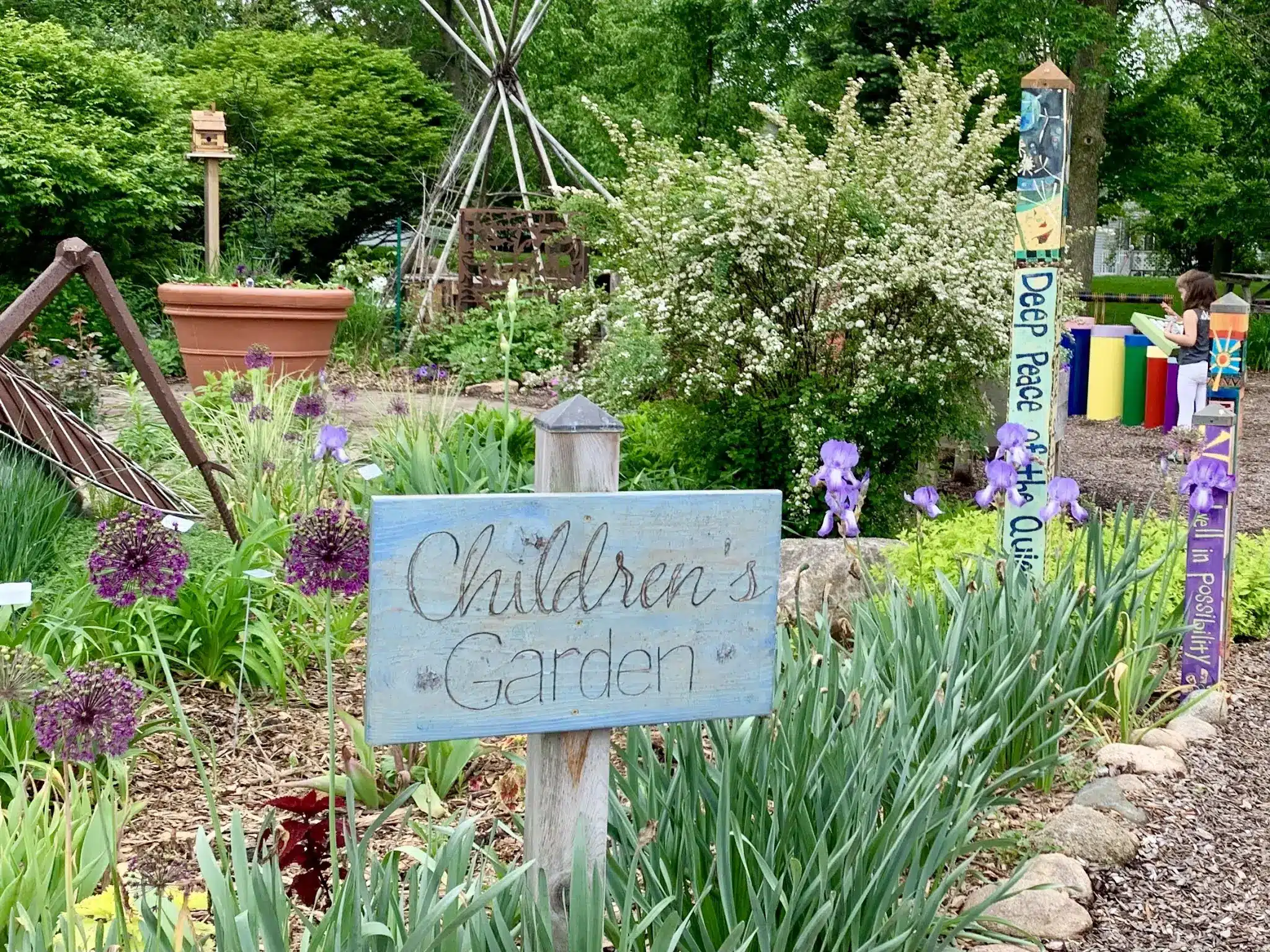
3. Incorporating Outdoor Art Areas
- Art Projects: Suggest specific art projects using natural materials, emphasizing creativity and environmental awareness.
- Integration with Nature: Explain how art in outdoor classrooms can help children express their observations and feelings about nature.
Outdoor art areas in preschool settings can be magical spaces where natural beauty inspires creativity. These areas can be equipped with easels where children can paint landscapes or still lifes of plants and objects found in nature, using both traditional art supplies and natural materials like leaves, twigs, and stones. Encourage children to explore different mediums by providing clay for sculpture, using the natural environment as a backdrop for storytelling and drama, or weaving with grasses and vines.
Additionally, consider the installation of a permanent outdoor structure, such as a mosaic wall, where each class can add pieces over the year, creating a lasting legacy of the children’s artistic contributions. This not only beautifies the outdoor classroom but also instills a sense of pride and community among the students. Incorporating light and shadow through objects like sundials or colored glass sculptures can teach children about the interplay between light, color, and shadow, integrating science and art in a hands-on learning experience.
4. Building Natural Playgrounds
- Design Elements: Detail the components of natural playgrounds, such as logs for balance beams, boulders for climbing, and spaces for imaginative play.
- Physical and Cognitive Benefits: Discuss how these playgrounds promote physical health, risk assessment skills, and cooperative play.
Natural playgrounds are designed to blend into the landscape, using materials that are part of the natural world. Instead of plastic slides and metal swings, imagine a playground with boulder climbing areas, log balance beams, and sand pits. These elements encourage imaginative play and risk-taking in a safe environment. A natural playground might also include a water play area with a pump and channels for water to flow through, teaching children about water movement and physics in a playful setting.
To further enrich the experience, integrate a construction zone where children can build with large, natural blocks of wood, branches, and other materials. This area can teach basic engineering concepts, teamwork, and problem-solving skills as children design and construct their own play structures. Adding a music and sound area with natural materials that produce sounds, like bamboo chimes or stone xylophones, can enhance sensory experiences and introduce children to musical concepts through exploration and play.
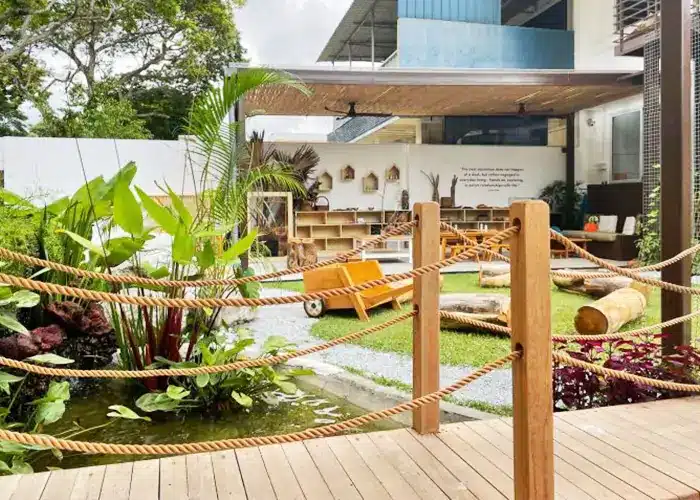

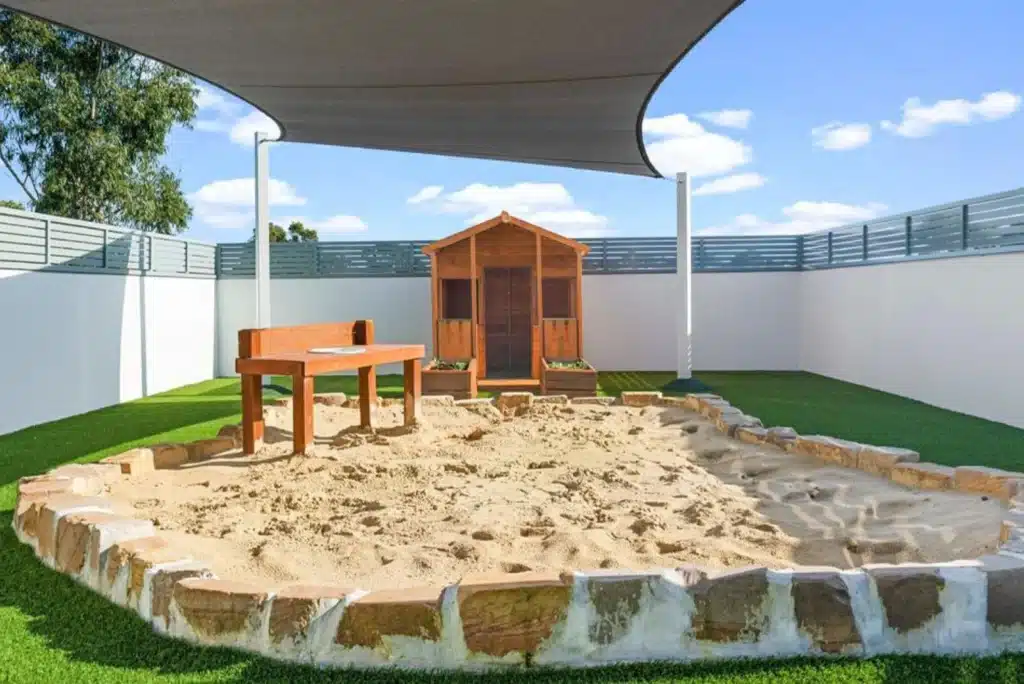


5. Implementing Weather Stations
- Tools and Equipment: Describe the setup of a basic weather station, including rain gauges, wind vanes, and thermometers.
- Learning Outcomes: Highlight how tracking weather patterns and changes can teach children about science, geography, and the environment, fostering a deeper understanding of the world around them.
Integrating a weather station into the outdoor classrooms provides a hands-on way for children to connect with the environment and understand the science behind weather patterns. Equip the station with simple tools like thermometers, rain gauges, wind vanes, and barometers. Children can engage in daily observations, record their findings, and learn to predict weather changes. This real-world data collection supports early math skills through charting and graphing weather patterns over time.
To deepen their understanding, children can participate in experiments that illustrate weather concepts, such as creating a mini greenhouse to learn about the greenhouse effect or using a lamp to explain how the sun warms the Earth. These activities not only teach scientific principles but also foster environmental stewardship by highlighting the importance of weather and climate in our lives.


6. Setting Up Sensory Paths
- Design Considerations: Detail the variety of materials that can be used to create sensory paths, such as smooth stones, bark mulch, and soft grass, and how these paths can be laid out to stimulate different senses.
- Benefits for Development: Explain the role of sensory paths in developing fine and gross motor skills, balance, and sensory integration, which are crucial in early childhood development.
Sensory paths in outdoor classrooms offer a unique avenue for developmental growth, engaging children’s sense of touch, balance, and spatial awareness. Design paths with a variety of textures—smooth stones, rough bark mulch, soft grass, and uneven sand. Each section can challenge children in different ways, encouraging them to navigate the path by hopping, skipping, or walking backward.
Incorporate elements that stimulate other senses along the path, such as aromatic plants for smell, rustling leaves for sound, and visually stimulating flowers and foliage. These multisensory experiences support cognitive development, language skills, and emotional regulation as children describe their experiences, express preferences, and learn to navigate and interact with diverse environments.
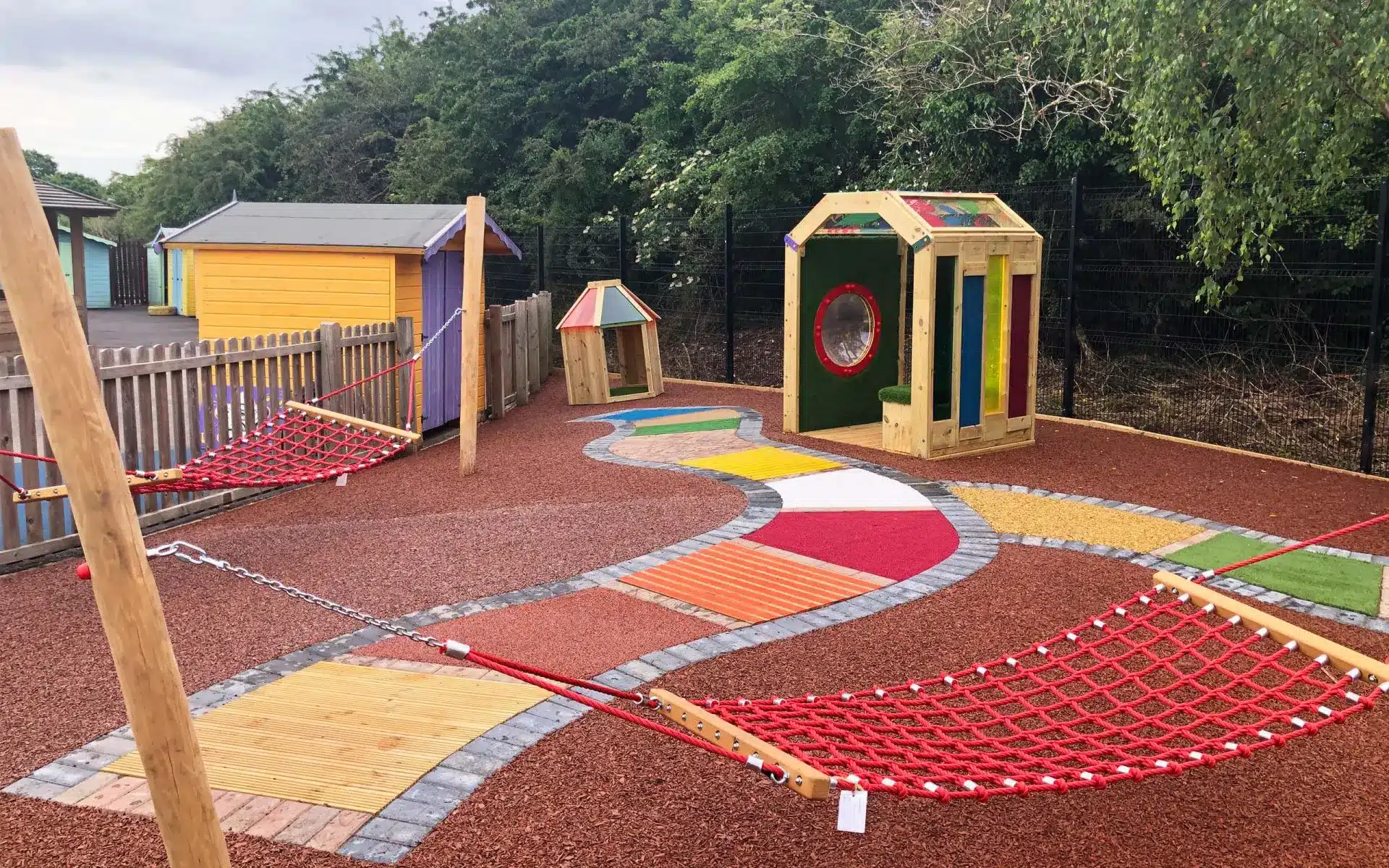
7. Organizing Outdoor Story Corners
- Creating the Space: Describe how to design a cozy, inviting outdoor reading area using natural elements like tree stumps for seating and canopies for shade.
- Literacy and Imagination: Discuss how storytime in nature can enhance listening skills, expand vocabulary, and ignite imagination, making literature come alive in the context of the natural world.
Create a tranquil corner of the outdoor classroom dedicated to storytelling and reading, furnished with natural seating like tree stumps or boulders, and shaded by trees or canopies. This area becomes a sanctuary where imagination is kindled through stories that connect children to nature, other cultures, and new ideas.
Regular storytelling sessions can be enriched with guest storytellers from the community, puppet shows that bring stories to life, and themed book weeks that explore various topics like animals, plants, and the seasons. This not only enhances literacy skills but also builds a communal spirit and love for reading in a relaxed, natural setting.

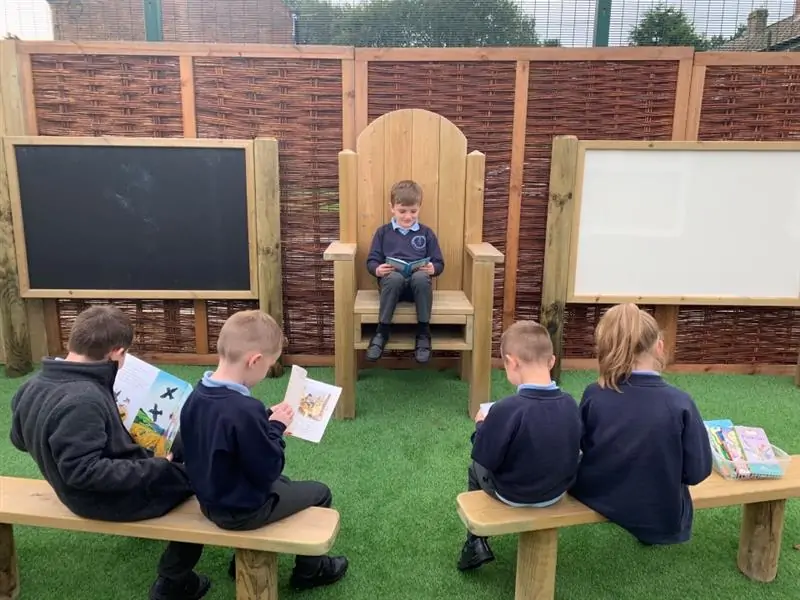

8. Integrating Eco-Friendly Practices
- Sustainable Activities: List specific sustainable practices that can be taught in outdoor classrooms, such as recycling, water conservation, and using solar energy.
- Long-term Impact: Emphasize the importance of instilling environmental stewardship in young learners, preparing them to be conscientious citizens who value and protect their planet.
Fostering a culture of sustainability within outdoor classrooms teaches children the value of environmental stewardship from an early age. Start a composting project where children learn to separate food waste and observe the decomposition process, understanding the cycle of organic matter. Water conservation practices can be introduced through rainwater harvesting systems that children help maintain and use to water the garden.
These eco-friendly practices can be woven into everyday activities, teaching children the impact of their actions on the environment and empowering them with the knowledge and skills to make a difference. Discussions around recycling, energy conservation, and the importance of biodiversity can help instill a sense of responsibility and care for the planet.
9. Utilizing Outdoor Science Labs
- Lab Setup: Offer ideas for setting up simple, yet effective outdoor science experiments that engage children in hands-on learning about physics, chemistry, and biology.
- Curiosity and Critical Thinking: Highlight how outdoor science labs can spark curiosity, encourage questions, and develop critical thinking skills as children explore scientific concepts in a real-world setting.
Outdoor science labs invite children to become young scientists, engaging in experiments and explorations that reveal the wonders of the natural world. Set up investigation stations where children can examine soil samples, observe insect behavior, or study plant growth. Equip these stations with magnifying glasses, microscopes, and simple lab tools to encourage detailed observation and inquiry.
Projects like building a simple weather vane, studying the effects of sunlight on different surfaces, or observing the phases of the moon connect classroom learning with the natural world. These experiences nurture curiosity, critical thinking, and a scientific mindset, laying the foundation for lifelong learning and exploration.

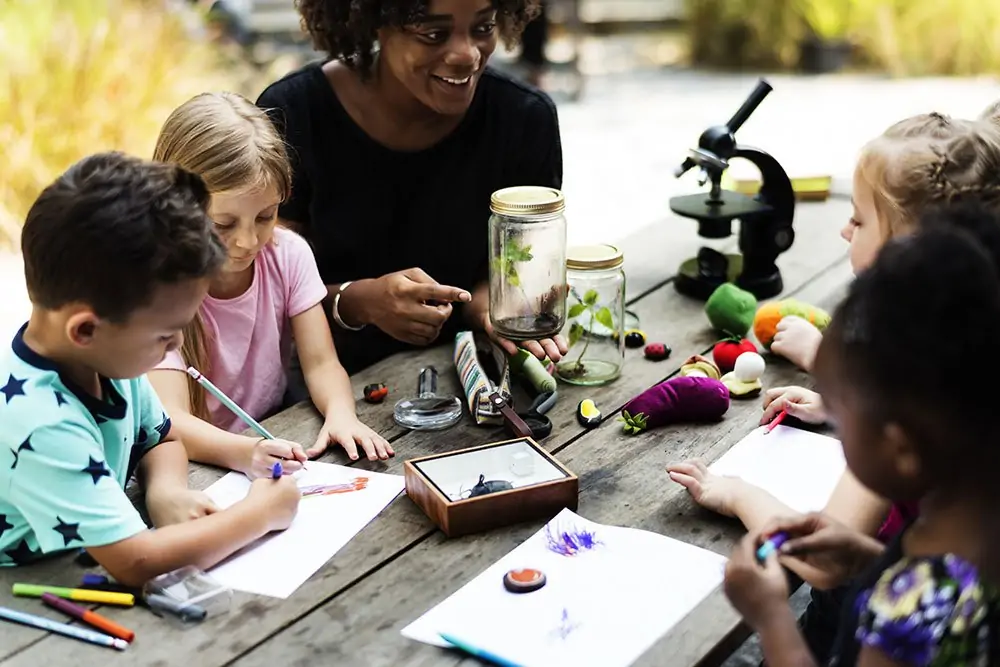
10. Promoting Physical Education through Adventure Courses
- Course Design: Provide insights into designing age-appropriate adventure courses that include elements like rope bridges, tunnels, and climbing nets.
- Holistic Development: Discuss how navigating these courses can help improve physical fitness, coordination, and problem-solving skills, and how overcoming obstacles can boost confidence and perseverance.
Adventure courses in outdoor classrooms offer a dynamic way to promote physical health and teamwork. Design the course with age-appropriate challenges that require a combination of strength, balance, and coordination, such as rope bridges, climbing nets, and tunnel crawls. These activities not only improve physical fitness but also boost confidence, perseverance, and social skills as children encourage and help each other overcome obstacles.
Incorporating elements of play and competition, such as timed races or team challenges, can make physical education exciting and engaging. Lessons on healthy living, the importance of physical activity, and goal setting can be integrated, making the adventure course a cornerstone of a holistic education that values the mind and body.

How Can Outdoor Classrooms Benefit Children’s Mental and Physical Health?
In the digital age, where screen time often dominates much of our children’s daily routines, the introduction of outdoor classrooms serves as a vital counterbalance, promoting both mental and physical well-being. Outdoor classrooms are not just alternative teaching spaces; they are vibrant ecosystems that offer rich, multi-sensory learning experiences beyond the confines of four walls. These environments naturally encourage physical activity, whether through structured games or unstructured exploration, helping combat the sedentary lifestyle that has become prevalent among young children.
Physical Health Advantages
- Increased Physical Activity: Regular exposure to outdoor classrooms encourages children to move, run, jump, and engage in physical play, which are critical for developing motor skills, enhancing physical fitness, and reducing the risk of obesity.
- Sunlight Exposure: Being outdoors increases children’s exposure to natural sunlight, a crucial source of Vitamin D, essential for bone health and immune system function.
Mental Health Benefits
- Stress Reduction: Natural settings have been shown to lower stress levels in children. The tranquil atmosphere of outdoor classrooms, filled with the sounds of nature, provides a calming effect, contrasting the often overstimulating indoor environments.
- Enhanced Focus and Attention: Studies suggest that children who spend time in nature have longer attention spans and improved memory and cognitive function. Outdoor learning can break the monotony of traditional classroom settings, helping to maintain engagement and concentration.
Promoting Emotional Well-being
- Fostering Independence and Confidence: Outdoor learning environments provide children with opportunities to take risks, make decisions, and solve problems independently, fostering self-esteem and confidence.
- Encouraging Social Interaction: Outdoor classrooms often require collaborative activities that encourage children to work together, communicate, and build friendships, vital for emotional development and social skills.
Enhancing Learning Outcomes
Beyond the health benefits, outdoor classrooms enrich academic learning through hands-on experiences that connect theoretical knowledge to the real world. Science lessons come alive through direct interaction with nature, mathematics becomes more tangible through environmental measurements, and literature gains depth with storytelling under the open sky.
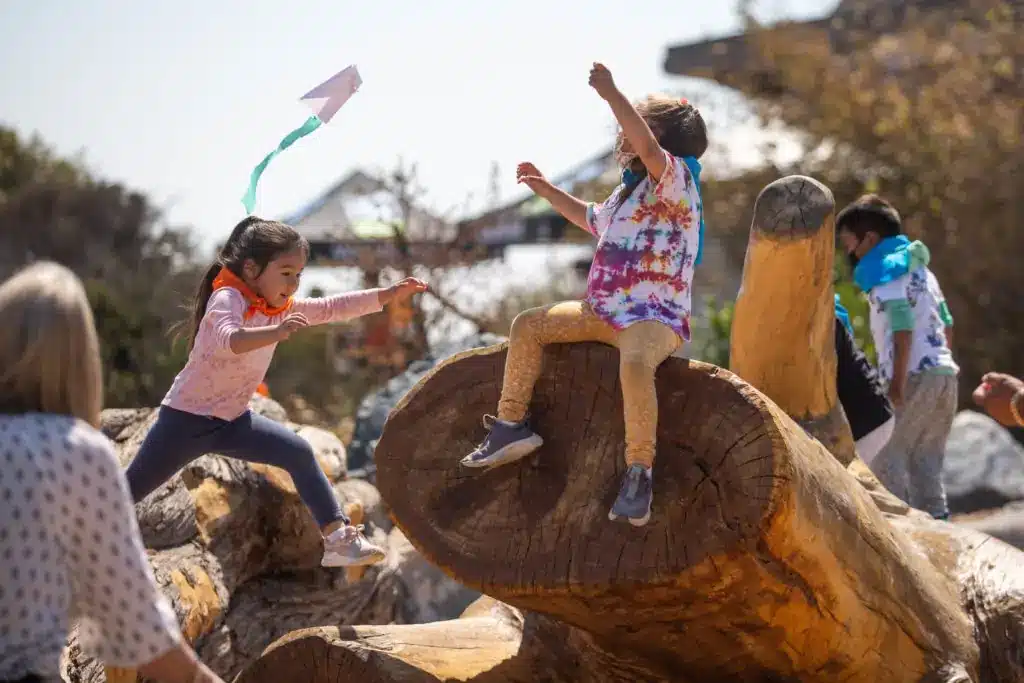
Can Outdoor Learning Continue Throughout the Year, Regardless of Weather?
Yes, outdoor learning can continue throughout the year by adapting to different weather conditions. This requires proper planning and resources, such as weather-appropriate clothing for students, sheltered areas for protection from rain or snow, and activities that can be enjoyed in various seasons. Winter can provide opportunities for lessons on weather patterns, snow science, and the changing seasons, while rainy days can offer lessons on water cycles and ecosystems. By embracing the elements, teachers can instill resilience and adaptability in students, showing them the value of experiencing and learning from all types of weather.
Outdoor classrooms are a dynamic extension of traditional learning spaces, offering diverse benefits that touch on every aspect of a child’s development. From enhancing physical and mental health to integrating curriculum objectives with the natural world, these spaces provide invaluable opportunities for hands-on learning, fostering a sense of community, and teaching resilience through year-round outdoor experiences. With careful planning, consideration of safety, and a commitment to inclusivity, outdoor classrooms can become a cornerstone of holistic education, preparing children not just academically, but also socially and emotionally for the challenges of the future.
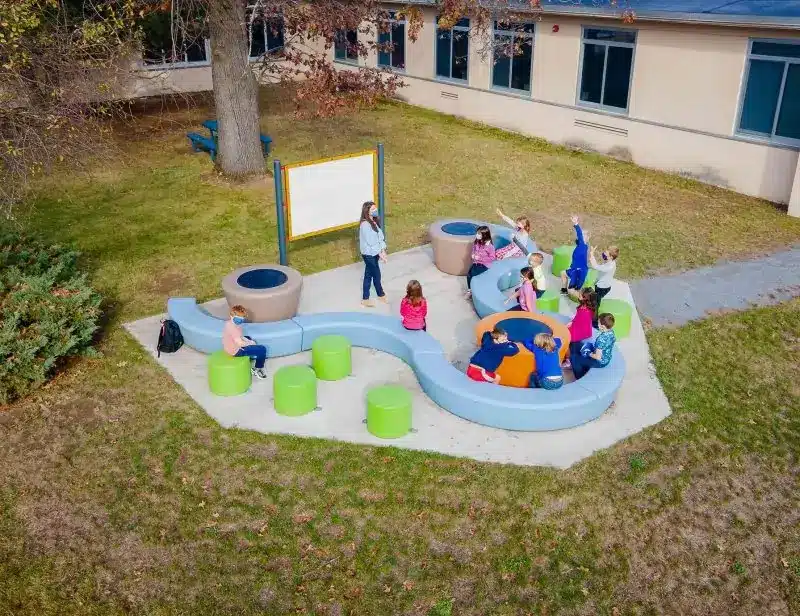
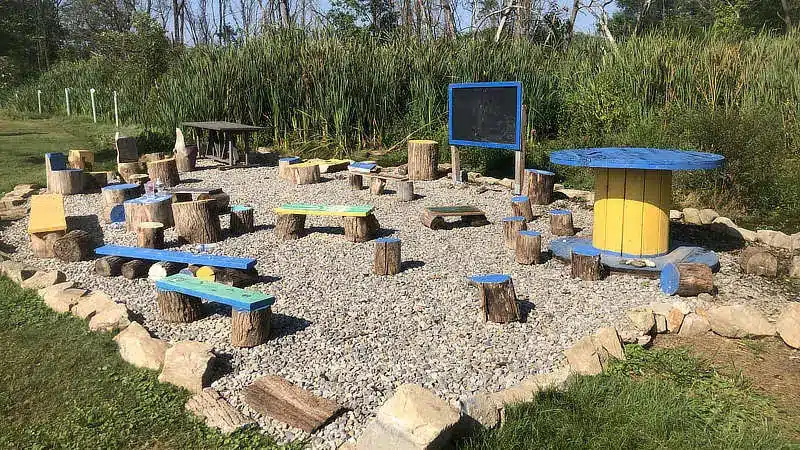
Outdoor classrooms are not merely an educational trend but a transformative approach that enriches learning by connecting students with the natural world. They offer a holistic educational experience that nurtures not only the intellect but also the physical, emotional, and social facets of every child.
By integrating curriculum objectives into the vibrant and ever-changing classroom of the outdoors, educators can provide more engaging, relevant, and meaningful learning experiences. Safety, community, and adaptability are key components in maximizing the benefits of outdoor learning, ensuring it is a positive, inclusive, and enriching experience for all students, regardless of the weather or season.
As we look towards the future of education, it’s clear that outdoor classrooms hold the key to fostering resilient, informed, and environmentally conscious individuals, ready to face the challenges of tomorrow with confidence and curiosity. The journey into outdoor learning is an invitation to reimagine education, making it more dynamic, interactive, and connected to the world around us.
Frequently Asked Questions about Outdoor Classrooms in Preschool
- What is an outdoor classroom?
An outdoor classroom is a dedicated learning space outside the traditional indoor environment where preschool children can explore, play, and learn through direct interaction with nature. Outdoor classrooms may include areas for gardening, building, storytelling, water and sand play, and more, encouraging curiosity and creativity while connecting children with the world around them. - What are the key elements of a successful preschool outdoor classroom?
A well-designed outdoor classroom typically includes natural materials (like logs, rocks, or sand), activity zones (e.g., garden areas, water play, building blocks), shade and seating, storage for outdoor tools, and clear boundaries to ensure safety. - What are the benefits of an outdoor classroom?
Outdoor classrooms offer preschoolers a dynamic environment that supports physical development, creative thinking, and social interaction. By engaging with natural materials and open-ended activities, children gain hands-on learning experiences that foster curiosity and problem-solving skills. These spaces also promote emotional well-being and reduce stress through regular exposure to nature. - How can I design an outdoor classroom on a budget?
You can use recycled materials, repurpose wooden pallets, collect natural resources like stones and leaves, and involve parents in donations or volunteer building days. Focus on functionality and flexible spaces rather than expensive equipment. - Can outdoor classrooms be used in all seasons?
Absolutely. With seasonal adjustments like proper clothing (e.g., rain boots, coats, sun hats), shade structures, and wind barriers, outdoor classrooms can function year-round and offer valuable lessons about seasonal changes. - How do outdoor classrooms enhance preschoolers’ connection to nature?
Regular interaction with plants, insects, soil, and weather fosters curiosity, respect, and love for the natural world. Outdoor classrooms teach children to observe, care for living things, and become more environmentally responsible from an early age. - Are outdoor classrooms safe for preschool children?
Yes, with proper planning. Safety can be ensured by using age-appropriate equipment, providing adult supervision, establishing clear rules, and maintaining outdoor materials regularly. Design should also include shaded areas and safe, soft surfaces.
Conclusion
Outdoor classrooms in preschool are more than just an extension of indoor learning—they are powerful spaces where children explore, create, and connect with the world around them. By incorporating thoughtful design and nature-based activities, educators can foster meaningful learning that supports all areas of development. Whether you have a large playground or a small garden space, outdoor classrooms offer endless opportunities to inspire curiosity and growth in young learners. Start small, think creatively, and watch the benefits bloom.




